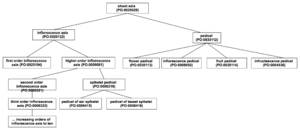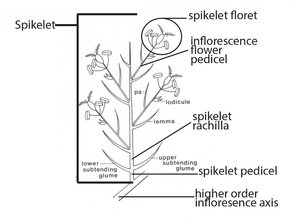Mar 21st, 2017 Ontology Working Group Meeting: Difference between revisions
| Line 16: | Line 16: | ||
==New inflorescence terms== | ==New inflorescence terms== | ||
[https://docs.google.com/document/d/18HF9rV18-nUZ6KBp-mi2p1CKHi-pF_eRRmecj582VCo/edit?usp=sharing Inflorescence types] | [https://docs.google.com/document/d/18HF9rV18-nUZ6KBp-mi2p1CKHi-pF_eRRmecj582VCo/edit?usp=sharing Inflorescence types] | ||
inflorescence (PO:0009049) | |||
Current def’n: | |||
A reproductive shoot system (PO:0025082) that has as parts all of the shoot axes (PO:0025029) distal to the most distal foliage leaf (PO:0009025) of a shoot axis and all of the flowers (PO:0009046) borne by those axes. Must have two or more flowers as parts. | |||
Revised def’n: | |||
A reproductive shoot system (PO:0025082) that has as parts all of the shoot axes (PO:0025029) and flowers (PO:0009046; must have two or more) distal to the most distal leaf (PO:0009025). | |||
Current comment: | |||
Some plants have only solitary flowers, e.g. Magnolia. | |||
Revised comment: | |||
Some plants, for example Magnolia, have solitary flowers (PO:0009046). ; Inflorescences are monopodially- and/or sympodially-arranged reproductive shoot systems from which at least two flowers develop. The axes of an inflorescence can be determinate or indeterminate. The orientation of higher order inflorescence axes (PO:0009081) relative to the first order inflorescence axis (PO:0025104) is informative when distinguishing between inflorescence types. | |||
Revised comment: | |||
Inflorescences are reproductive shoot systems from which at least two flowers develop. | |||
The growth pattern of an Inflorescences may be monopodial (single main shoot axis), or sympodial (growth occurs from axillary meristems). The axes of an inflorescence can be determinate or indeterminate. Many plants, for example Magnolia, have solitary flowers (PO:0009046). | |||
comments: | |||
Expand on monopodial and/or sympodial | |||
Open PATO tracker with proposed definitions | |||
Move comment about single flowers to the end of main comment | |||
https://github.com/pato-ontology/pato/issues | |||
Current synonyms: | |||
inflorescencia (Spanish, exact), 花序 (Japanese, exact), Asteraceae floret (narrow), | |||
ament (narrow) | |||
anthela (narrow) | |||
anthelae (narrow) | |||
bostryches (narrow) | |||
bostryx (narrow) | |||
capitula (narrow) | |||
capitulum (narrow) | |||
catkin (narrow) | |||
cincinni (narrow), cincinnus (narrow) | |||
corymb (narrow), cyathia (narrow), cyathium (narrow), cyme (narrow), cymule (narrow), dichasium (narrow), drepanium (narrow) | |||
glome (narrow), glomerule (narrow) | |||
head (narrow), helicoid cyme (narrow), | |||
monochasium (narrow), | |||
panicle (narrow), | |||
raceme (narrow), | |||
rhipidia (narrow), rhipidium (narrow), | |||
scorpioid cyme (narrow), spadices (narrow), spadix (narrow), spike (narrow), | |||
thyrse (narrow), Triticeae spike (narrow) | |||
umbel (narrow) | |||
verticillaster (narrow) | |||
Revised synonyms: inflorescencia (Spanish, exact), 花序 (Japanese, exact), infloreszenz (?, German, exact) | |||
https://github.com/Planteome/plant-ontology/issues/260 | |||
==Revisions to pedicel terms== | ==Revisions to pedicel terms== | ||
Revision as of 18:15, 4 April 2017
Planteome Ontology WG Zoom Meeting
- Date: Tuesday March 21st, 2017
- Time: 8:15am PST (GMT-8)
- Connection details: Join from PC, Mac, Linux, iOS or Android: https://zoom.us/j/513811918
- Attendees: LC, AM, PJ, JE, DWS, BSinn, DC, GG, CM, EA, MAL
- Regrets: n/a
- Recordings:
Agenda
New inflorescence terms
Inflorescence types inflorescence (PO:0009049) Current def’n: A reproductive shoot system (PO:0025082) that has as parts all of the shoot axes (PO:0025029) distal to the most distal foliage leaf (PO:0009025) of a shoot axis and all of the flowers (PO:0009046) borne by those axes. Must have two or more flowers as parts.
Revised def’n: A reproductive shoot system (PO:0025082) that has as parts all of the shoot axes (PO:0025029) and flowers (PO:0009046; must have two or more) distal to the most distal leaf (PO:0009025).
Current comment: Some plants have only solitary flowers, e.g. Magnolia.
Revised comment: Some plants, for example Magnolia, have solitary flowers (PO:0009046). ; Inflorescences are monopodially- and/or sympodially-arranged reproductive shoot systems from which at least two flowers develop. The axes of an inflorescence can be determinate or indeterminate. The orientation of higher order inflorescence axes (PO:0009081) relative to the first order inflorescence axis (PO:0025104) is informative when distinguishing between inflorescence types.
Revised comment:
Inflorescences are reproductive shoot systems from which at least two flowers develop.
The growth pattern of an Inflorescences may be monopodial (single main shoot axis), or sympodial (growth occurs from axillary meristems). The axes of an inflorescence can be determinate or indeterminate. Many plants, for example Magnolia, have solitary flowers (PO:0009046).
comments: Expand on monopodial and/or sympodial Open PATO tracker with proposed definitions Move comment about single flowers to the end of main comment
https://github.com/pato-ontology/pato/issues
Current synonyms:
inflorescencia (Spanish, exact), 花序 (Japanese, exact), Asteraceae floret (narrow),
ament (narrow) anthela (narrow) anthelae (narrow) bostryches (narrow) bostryx (narrow) capitula (narrow) capitulum (narrow) catkin (narrow) cincinni (narrow), cincinnus (narrow) corymb (narrow), cyathia (narrow), cyathium (narrow), cyme (narrow), cymule (narrow), dichasium (narrow), drepanium (narrow) glome (narrow), glomerule (narrow) head (narrow), helicoid cyme (narrow), monochasium (narrow), panicle (narrow), raceme (narrow), rhipidia (narrow), rhipidium (narrow), scorpioid cyme (narrow), spadices (narrow), spadix (narrow), spike (narrow), thyrse (narrow), Triticeae spike (narrow) umbel (narrow) verticillaster (narrow)
Revised synonyms: inflorescencia (Spanish, exact), 花序 (Japanese, exact), infloreszenz (?, German, exact)
https://github.com/Planteome/plant-ontology/issues/260
Revisions to pedicel terms
Plans for publications
From PJ: Think about putting our whitepapers or docs on ontology development here: http://biorxiv.org/about-biorxiv. They become citable and can be updated.
- DWS: Here are some that NY grouop are working on:
- PO for Fruit
- PO for Inflorescence
- PO for Seed
- PO for Lenticel and other wound responses
- CM:
- design patterns for TO
- axiomatization of EO
- Samara, GRIN traits
- interactions/diseases
Year Three Goals
Upcoming Meetings and Workshops
Biocuration 2017, March 26-29, 2017
- Stanford University, Palo Alto, California, United States
- http://biocuration2017.org
- Upcoming deadlines:
- Abstract submission for poster ONLY February 17, 2017
- Early conference registration February 17, 2017
- Online conference registration March 10, 2017
- Submission email: biocuration2017@lists.stanford.edu
- Biocuration 2017 will bring together hundreds of leading curation scientists, bioinformaticians, and developers from all over the world to discuss their work, promote collaboration and foster a sense of community in this very active and growing area of research.
2017 Gene Ontology Consortium Meeting, June 1-5th, 2017, Corvallis
- Dates: June 1-5, 2017 (Details)
- Arrive (May 31) View travel directions
- GOC meeting (June 1-3)
- Noctua gene annotation jamboree (June 4)
- Reactome Pathway curation jamboree (June 5)
- Depart (June 5 late evening / June 6 anytime)
Plant Biology 2017, June 24th-28th, Honolulu, Hawaii
- Important deadlines:
- April 30, 2017: Deadline for early-bird registration rates for Plant Biology 2017 and iMOSS 2017.
- May 24, 2017: Deadline for submission of abstracts to be included in the online program book and to receive a poster number.
- May 27, 2017: Deadline for discount hotel rates. (Please note: Our discounted room block may fill up long before this deadline.)
- June 12, 2017: Final deadline for Plant Biology 2017 abstract submissions.
- June 12, 2017: Deadline for standard registration rates for Plant Biology 2017 and iMOSS 2017.
- June 24–28, 2017: Onsite registration during Plant Biology 2017!
XIX International Botanical Congress, July 23-29, 2017, Shenzhen, China
- Workshop proposal accepted-
- T5-06:Ontologizing botanical knowledge (two sessions)
- Organizer: Hong Cui (University of Arizona, USA)
- James Macklin (Agriculture Agri-Food Canada, Canada)
- Pankaj Jaiswal (Oregon State University, USA)
- T5-18: Bioinformatics resources for comparative functional and phylogenetic analysis of plant genomes, pathways and diversity
- Organizer: Pankaj Jaiswal (Oregon State University, USA)
- Sushma Naithani (Oregon State University, USA)
- Deadline for the abstract submission for oral presentations has been extended for 39 of the 212 general symposia where one or a few speaker slots are available
- New deadline: February 15, 2017 for those 39 symposia and for posters only
- Abstract submitted? Not yet
ICBO 2017, Sept 12th-15th, 2017
- Newcastle, GB
- http://icbo.buffalo.edu/
- Important dates:
- Mar 29, 2017: Workshops and tutorials proposals submission deadline
- Apr 19, 2017: Notification of acceptance of workshops and tutorials
- Jun 02, 2017: Paper and Poster Deadline
- Jun 16, 2017: Paper Reviews Due

